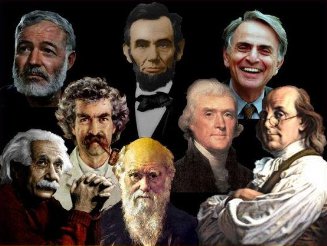I am teaching a new course at Lake Forest College. It’s called “Atheism and Faith”. I can only hope the students are enjoying it as much as I am. We’re focusing on the “new atheists”, so the first book we read is Sam Harris’s The End of Faith. He’s one of the poster boys for this coterie of fundamentalist scientists who rage against fundamentalist religionists, failing to see that their fundamentalist mindset makes them closer to their opponents than their dogmas distance them.
The shallowness of these “new atheists” makes me long for the “great atheists” like Friedrich Nietzsche and Ludwig Feuerbach. I’ve been teaching Nietzsche at Common Ground Deerfield. Reading Nietzsche is like sitting down to a seven-course dinner after living for six months on frozen TV entrees (the “new atheists”).
People use atheism in so many different ways. One woman I met at a dinner party told me that she was an atheist but she believed that “human nature was good and that something in the universe is inviting us to do good”. I smiled as I thought of what Nietzsche might have said to her. Atheist indeed!
Nietzsche was a great atheist because he both saw and accepted the consequences of atheism. To deny the divine mystery at the heart of being, a mystery that gives the universe a grain and gives us a nature, means denying both grain and human nature. All is absurdity and randomness. The ultimate claim of the atheist is that all meaning both in the universe and in your own life begins and ends in your mind.
This is what Paul Tillich meant in saying that atheism lacks depth. He didn’t mean that atheists were shallow thinkers but that they regard all experiences as beginning and ending in themselves. In other words, they don’t regard their experience as connecting them with anything deeper. Notice that I say, “regard”. It may well be that an atheist is really a mystic but at the same time is someone who has designed a world in which mystics can’t exist.
Some years ago I was part of the examining committee in a student thesis defense. He was a psychology major and a member of a humanistic Jewish synagogue. I asked him how he would react if he were sitting by the lake and suddenly had an overwhelming experience of love and compassion such that the whole world appeared beautiful and at peace. He responded that he would immediately see his doctor to find out what kind of chemical imbalance was producing such aberrant behavior.
In Hinduism we are told that the ultimate reality is Satchitananda: truth, consciousness, and bliss. In the first Letter of John in the New Testament (4:16b) we are told that God is love and those who abide in love abide in God and God abides in them. This means that our awareness of truth, our consciousness, our joy, and our love do not begin and end in our mind but rather are rooted in the very source of reality, that eternal fountain of To-Be-Ness from which all things flow.
Can this ever be proved? No. But is there more evidence for trusting mystical truth rather than atheistic arguments? I think so. Is it merely coincidence that the embodiments of these traditions bear such close family resemblances to one another? When you put Rabbi Heschel, Fr. Keating, Dr. Irfan Kahn in a line-up, is it just a strange coincidence that they are all wise, compassionate, humble, energetic, personable, and active in the world of social justice? Each of these men has followed a spiritual path for many years—the way of the Torah, the way of Jesus, the way of the Qur’an. They give us a vision of what human beings can be. They show us the next stage of our cultural and spiritual evolution. They point to a sustainable human future. I personally find more reason to trust their truth than the arguments of Sam Harris, Christopher Hitchens, and Richard Dawkins.
By Ron Miller, April 17, 2011
